Good Friday 2024
300 years of Johann Sebastian Bach’s St. John Passion
How do we get as close as possible to the 1724 version of the St. John Passion in 2024? What performance material is needed? Here you will find some practical performance thoughts, also on the 1725 version, from chief editor Dr. Uwe Wolf.
During his first Lent in Leipzig in the spring of 1724, Johann Sebastian Bach composed the St. John Passion, BWV 245.1, performing it on Good Friday in the Nikolaikirche. Afterwards, he presumably lent out all the performance scores, while (as was customary) keeping the duplicates, namely the parts for violins I/II, and continuo, as well as the ripieno parts for the choir. It seems that the lent parts were never returned, because Bach had to have everything apart from these few duplicates rewritten for the repeat performance of the Passion in 1725.
Unfortunately, the autograph score has not survived. Today we only have a copyist’s version of the autograph from movements 11 onwards, probably written down in the 1740s by Bach himself.
From the surviving parts, it’s fairly clear that the 1724 version was very close to that of 1749 (BWV 245.5), today known as “Version IV”. There are some significant textual deviations in movements 9 and 19/20. Furthermore, movements 19 and 20 in the 1724 version feature the exquisite instrumentation of two violas d’amore and lute (later replaced by violins con sord. and organ).
Those wishing to recreate the 1724 version of the St. John Passion in 2024 can proceed as follows using the performance materials for the 1749 version:
Play movements 1-8 and 10 from the full score and material of the Carus edition of Version IV (Carus 31.245/00), edited for Carus by the current director of the Leipzig Bach Archive, Professor Peter Wollny. But do not use the version given in the appendix, which reproduces the unfinished revision (BWV 245.4) probably begun in 1738 and not performed in Bach’s time. The appendix can, however, be used for movement 9, the original 1724 version of which has been completely lost. There is evidence to show that movement 9 of the 1738 version is textually identical to the 1724 version. Any differences in the musical treatment will – as far as can be determined from the 1749 version – be minor.
Separate parts for movements 19 and 20 from the delightfully scored 1724 version can be ordered from Carus. The divergent text of the 1724 version is included in the vocal score of the 1749 version.
The “bassono grosso” did not feature in the 1724 version.
We can only speculate about other differences between 1749 and 1724. In particular, it’s impossible to determine from the handwritten copy whether flutes were foreseen or not, as it was standard practice for such non-independent flute parts to be left out of the score. Other differences are minor or unknown.
St. John Passion 1724 – materials required:
Full score: 31.245/00
Vocal score: 31.245/03
Choral score: 31.245/05
Instrumental parts: 31.245/19
In addition: parts for the alternative scorings of movements 19/20: 31.245/81+82
And 2025?
St. John Passion “O Mensch, bewein dein Sünde groß” (O man, thy grievous sins bemoan) from 1725 BWV 245.2
Just one year after its premiere, Bach performed the St. John Passion once again after having carried out some major revisions. Two large-scale chorale movements were introduced (including the new opening chorus “O Mensch, bewein dein Sünde groß” / “O man, thy grievous sins bemoan”), no doubt to better complement Bach’s chorale-cantata cycle of 1724/25. Some highly dramatic new arias once again reveal a completely different side to Bach. (for more details, see „Bach’s “other” St. John Passion from 1725“)
The 300th anniversary of this rarely heard and fascinating version of the St. John Passion invites us to approach the work from a different perspective – even if this means abandoning the beloved opening chorus “Herr, unser Herrscher” (Lord, thou our Master). The Carus edition of the 1725 version (like all other versions) was edited by one of the most renowned Bach scholars, Professor Peter Wollny, the current director of the Leipzig Bach Archive.
All performance materials for the 1725 version are published separately by Carus.
St. John Passion
Version IV: Herr, unser Herrscher
BWV 245 (BWV3 245.5, 245.4), 1749
Carus 31.245
St. John Passion
Version II: O Mensch, bewein
BWV 245 (BWV3 245.2), 1725
Carus 31.245/50
BWV 245, 1739/1749
BWV 245 (BWV3 245.5, 245.4), 1749
Carus 31.245/03

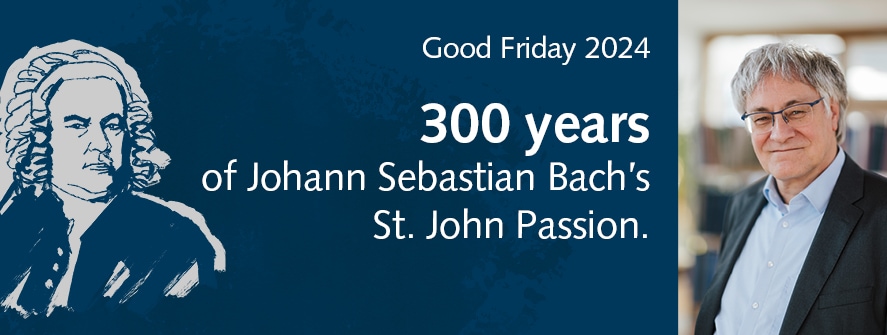

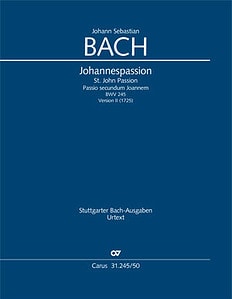
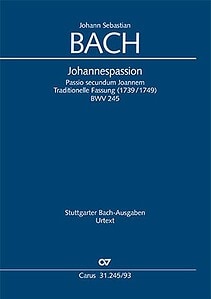


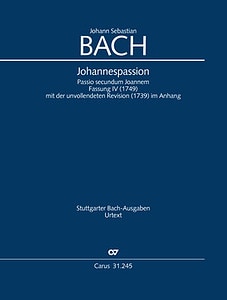


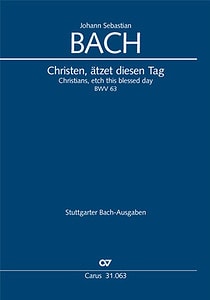





Leave a Reply
Want to join the discussion?Feel free to contribute!